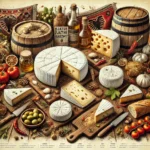Albania’s dairy heritage stretches across rugged mountain villages, fertile plains, and Mediterranean coastal valleys. Among the most significant products of this landscape is Djathe Dele, a traditional sheep’s milk cheese celebrated for its bold salinity, fine crumbly texture, and unmistakably Balkan aroma. Found across homes, tavernas, farmsteads, and markets, Djathe Dele is not just a cheese—it is an enduring expression of Albanian culinary identity.
🧀 What Is Djathe Dele?
The name literally translates to “sheep cheese” in Albanian, referring both to its milk source and its historical connection to pastoral life in Northern and Southern Albania.
Key Characteristics
| Attribute | Description |
|---|---|
| Milk | 100% sheep (occasionally sheep-goat blend) |
| Texture | firm, slightly crumbly, rich in butterfat |
| Flavor | salty, tangy, earthy, sheep-forward |
| Color | ivory white to pale cream |
| Aging | 2–6 months in brine |
| Aroma | grassy, herbal, clean but decisive |
Djathe Dele belongs to the brined cheese family, similar in category to Greek feta, Bulgarian sirene, or Montenegrin Njeguski sir, yet it maintains a distinct Albanian terroir.
🏔 Origins and Terroir
Albanian sheep cheese production thrives in:
-
Shkoder & Kelmend (northern Alps)
-
Korca & Pogradec (eastern mountains)
-
Gjirokastër & Vlorë (southern highlands)
-
Berat & Skrapar (central valleys)
Sheep graze freely in:
-
alpine pastures
-
medicinal herb fields
-
wild thyme beds
-
sage-covered hills
-
juniper grasslands
This natural grazing gives Djathe Dele its aromatic floral-herbal profile—a signature of Albania’s mountainous ecosystems.
🧂 Traditional Production Method
Cheese production remains mostly small-scale and artisanal, reflecting centuries-old shepherding practices.
Step-by-Step Process
-
Fresh sheep milk collection at dawn
-
Warm coagulation using natural rennet
-
Cutting curd into small cubes
-
Draining and pressing lightly
-
Salting and immersion in brine
-
Aging in wooden barrels or metal tins (known as kace)
Why Brine?
Brine acts as:
-
preservative
-
flavor enhancer
-
texture stabilizer
In Albania’s warm summers and cold winters, salt and brine secure long-term preservation without losing quality.
🧀 Flavor Profile: What Makes It Unique?
Unlike mild cow cheeses, Djathe Dele offers depth and distinctiveness:
-
Salty but balanced
-
Notes of sheep’s milk creaminess
-
Lactic brightness
-
Herbal mountain aftertaste
-
Slight tang from brining
Aging Effects
| Aging Time | Flavor | Texture |
|---|---|---|
| 2–3 months | milder, creamy | slightly elastic, semi-firm |
| 4–6 months | sharper, more complex | crumbly, dense, concentrated |
| 8+ months (rare) | intense, savory | brittle, dry, ideal for grating |
Long aging is treasured but less common due to high demand for fresh cheese.
🍽 Culinary Uses in Albanian Cuisine
Djathe Dele is deeply woven into daily food culture.
Traditional Serving Styles
| Dish | How It’s Used |
|—|—|—|
| Tavë Kosi | melted into baked yogurt-lamb casserole |
| Byrek me Djathë | layered pastry stuffed with salty cheese |
| Fërgesë | combined with peppers & tomatoes |
| Grilled Cheese | pan-fried or baked blocks |
| Bread & Olives | simple mezze pairing |
Contemporary Applications
-
salads with tomato, cucumber & oregano
-
bruschetta with honey or fig jam
-
grated over roasted vegetables
-
cheese boards with raki pairings
Because of its boldness, just a small crumble transforms dishes.
🌍 Comparison with Other Balkan Sheep Cheeses
| Cheese | Region | Similarity | Difference |
|---|---|---|---|
| Feta | Greece | brined, sheep | Djathe Dele is denser & bolder |
| Sirene | Bulgaria | crumbly | Albanian version has deeper herbal notes |
| Telemea | Romania | milk blend | Djathe Dele saltier & less creamy |
| Njeguski | Montenegro | sheep | Djathe Dele brined longer & firmer |
The Albanian cheese stands out for intensity and herb-fed milk character.
🧊 Storage & Handling
Because it is rich in salt and aged in brine, Djathe Dele remains stable but requires care.
Storage Rules
-
keep refrigerated
-
store in original brine
-
avoid airtight plastic (prevents fermentation breath)
Shelf Life
| Form | Duration |
|---|---|
| in brine | 6–8 weeks |
| drained | 7–10 days |
| vacuum-packed | up to 3 months |
Tip: If cheese is too salty, soak briefly in cold water or milk before serving.
🥂 Best Pairings
Traditional Drinks
-
Raki rrushi (grape brandy)
-
Mountain herbal tea
-
Local white wine
Modern Pairings
| Beverage | Reason |
|---|---|
| Sauvignon Blanc | bright acidity lifts saltiness |
| IPA beer | bitter hops balance fat |
| Dry cider | fruit meets creaminess |
Complementary Foods
-
ripe figs
-
roasted peppers
-
olives & capers
-
flatbread
-
walnuts & honey
The contrast between sheep saltiness and sweet fruits is spectacular.
🌿 Cultural Significance
Djathe Dele is:
-
pastoral memory
-
shepherd livelihood
-
mountain identity
-
home-table heritage
It travels from the alpine hut to the breakfast tray, from village cellars to Tirana restaurants.
Its continued popularity supports:
-
rural economies
-
traditional herd-grazing
-
dairy craftsmanship
⭐ Final Summary
Djathe Dele represents the soul of Albanian dairy culture—a brined sheep cheese shaped by mountains, herbs, and timeless shepherd life. Salty, sturdy, aromatic, and versatile, it remains central to both simple Balkan meals and refined Mediterranean platters.
Whether baked into byrek, crumbled into salads, or paired with figs and raki, Djathe Dele brings authentic Albania to every bite.
FAQs – Djathe Dele
1. What type of milk is used?
Traditionally 100% sheep’s milk, occasionally mixed with goat milk.
2. Is it very salty?
Yes, it is brined, but soaking reduces saltiness if needed.
3. How is it most often eaten?
In byrek, tavë kosi, salads, mezze platters, and grilled.
4. Can it be aged long?
Yes, but long aging intensifies salt and crumbly texture.
5. Where is it made in Albania?
Mainly in the Rhodope-Alpine regions like Korça, Shkoder, Gjirokastër and pastoral villages.



